Tracking Tibet's Transformation
The world's highest altitude train brings more than tourists to Tibet, long an isolated land at the Rooftop of the World. Already, there has been controversy over the impact of so many Chinese visitors. But the train also brings change to Tibetans. And trains run two ways. Already the railway puts China on track to re-evaluate its role in Tibet.
By Ron Gluckman/ in Tibet and on the train
"THE MAIN REASON TIBET is so undeveloped and un-Chinese—and so thoroughly old-fangled and pleasant,” wrote Paul Theroux in Riding the Iron Rooster, his 1989 account of traveling across China by train, “is that it is the one great place in China that the railway has not reached.
"The Kunlun Range,” he added, “is a guarantee that the railway will never get to Lhasa.”
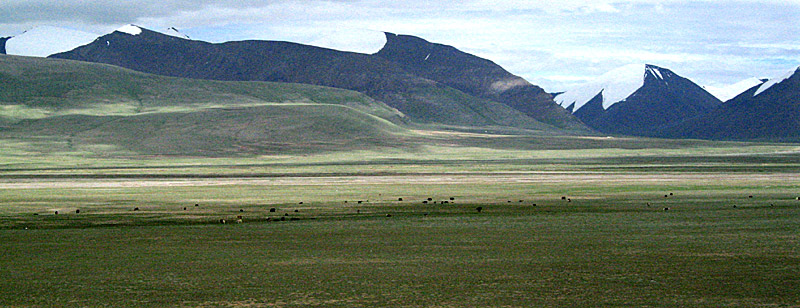
Theroux had ample reason to feel secure. Tibetans he visited lived largely as they did for generations, mumbling ancient prayers, filling temples, drinking yak-butter tea.
The Kunlun Mountains, which run between the Tibetan Plateau and the desolate wilds of China’s Xinjiang and Qinghai provinces, seemed an iron-clad guarantee that it would always be so.
Such were my thoughts as I scaled that same imposing Kunlun Range, not in arctic gear like great explorers before me, but in first class. Proving Theroux – and the rest of the world wrong – China had brought rail service to Tibet, and I was among the first passengers.
From picture windows, we watched enormous herds of yaks and antelope scatter across lush tundra as our train roared over the steppes.
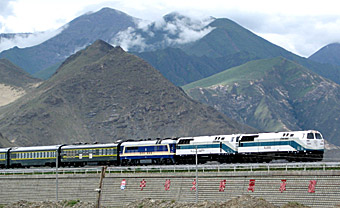 This had been a dream of Chinese leaders
for half a century. Tracks were pounded to desolate Golmud in the 1960s, but
plans to run railway to China’s sole province without train service ended in
the Cultural Revolution. By then, only half a kilometer of test track challenged
sprawling Qinghai Plateau.
This had been a dream of Chinese leaders
for half a century. Tracks were pounded to desolate Golmud in the 1960s, but
plans to run railway to China’s sole province without train service ended in
the Cultural Revolution. By then, only half a kilometer of test track challenged
sprawling Qinghai Plateau.
Construction resumed in 2001, on a railway few believed possible. Over much of the 1,120 kilometers, the train soars at heights rarely reached by small planes.
Eighty percent of track is at altitudes of 4,000 meters or more; 550 kilometers is over permafrost, where annual thaws and freezing sends ground heaving in all directions. Murray Hughes, editor of Railway Gazette International, called this “the world’s most ambitious railway construction project.”
Chinese engineers devised ingenious processes to mitigate the perilous land shifts. One feeds ammonia through tubes deep underground, effectively keeping permafrost on ice. Elsewhere, tracks are elevated over unstable ground, creating ethereal runs where we glided over vast stretches of grassland.
All the miracle engineering sent the budget to $4.2 billion – making this not only the world’s highest-altitude train but, mile on mile, the most expensive. Engineers had to predict climate change in a region rarely traversed, with minimal margin of error.
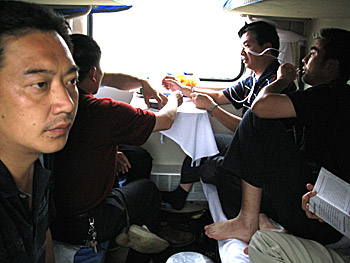 Wind rages at
50 miles per hour, while temperatures plunge to –30. Plus, the area is
earthquake prone, last rattled by a 8.1 tremor in 2001.
Wind rages at
50 miles per hour, while temperatures plunge to –30. Plus, the area is
earthquake prone, last rattled by a 8.1 tremor in 2001.
That it all worked was an undeniable marvel, more so as trains started July 1, years ahead of schedule. But critics wonder for how long? Already, there have been reports of cracks in the tracks, and a minor derailment. Altitude sickness claimed its first victim the month after launch, in August 2006.
Crossing Tanggula Pass, the train soared into clouds at 5,072 meters, higher than any European peak. My Ipod died, as did other digital devices. At this elevation, air contains half the oxygen as at sea level. Gasping, passengers grabbed for the on-board oxygen tubes.
No less severe is the impact on Shangri-la itself. It took half a century after Tibet’s absorption by China for tourism to top a million visitors in 2004. But that number will likely double again within a year of train service. By the end of the decade, five million visitors are expected annually.
China’s designs on its Final Frontier can be felt most vividly at the massive train station in Lhasa. Smartly designed in modern Tibetan style, sprawling bus lanes clearly denote plans for a future traffic boom.
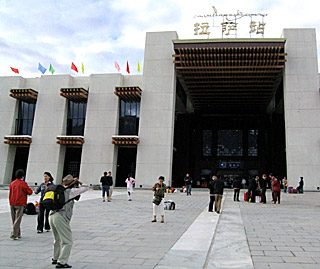 “Enjoy your time in Lhasa
now,” said Nema, practically the first Tibetan I met, at the station. “Next
time you come, it might not be Lhasa anymore. The train changes everything.”
“Enjoy your time in Lhasa
now,” said Nema, practically the first Tibetan I met, at the station. “Next
time you come, it might not be Lhasa anymore. The train changes everything.”
Many, like Folk Music Bar, with rough hewn tables, lively music jams, and tasty mix of Chinese dishes steeped in ethnic Tibetan flavors, are run by new arrivals from China.
“I like Tibet because it’s a big place, very open and free,” says Wang Yu, a 27-year-old woman from Chongqing who opened the bar with a friend from Xian.
The cobbled lane behind the Yak Hotel was transformed this summer into a stylish walkway of cafes, pubs and clothing shops. At Moment Bar, owner Xiao Liu, a 26-year-old Hangzhou woman, confided that this was the realization of a lifelong dream.
 Not merely opening her first
business in June, but being in Tibet. “I love the landscape and the culture.
This place is so mysterious.”
Not merely opening her first
business in June, but being in Tibet. “I love the landscape and the culture.
This place is so mysterious.”
Up and down the lane, and around Lhasa, Chinese entrepreneurs were injecting new energy into a land few cared to visit until recently. In 1994, on my first visit, official statistics reported 28,000 foreign tourists.
Chinese were too few to tally. In fact, through the 1990s, they claimed “legendary status” just by making the trip, says Zhang Jin, author of the China’s top-selling Tibetan guidebook. “They were like rock stars,” she notes. “Going to Tibet was an amazing thing then.”
That changed long before the launch of the train, and rolling across the Qinghai Plateau and high into the mountains, it was easy to see why. Most of the way, crossing Qiangtang Grassland, skirting bird nesting grounds at Cuona and Qinghai Lakes, we could look out the windows, mesmerized by the seemingly endless vastness.
Except when another car sped by on the nearby highway.
I marveled at the regular flow of vehicles – not land cruisers, but common cars. A decade ago, Tibet was a tortuous truck ride from Golmud attempted only by the most adventurous travelers.
When trucks on the six-day supply caravan from Chengdu slipped off one of the hair-pin curves, the Holiday Inn Hotel would be without supplies for weeks. The manager told me it had to be the only four-star hotel to provide newspapers and scissors, with apologies, instead of toilet paper.
 Back then - before protest groups chased
away the chain - the Holiday Inn was an oasis,
Tibet’s only international hotel, and the only place to make phone calls, get
news (TV and papers from outside China were banned) or, if you had the appetite,
munch a yak-burger. Culinary options were otherwise limited to bad Chinese or
worse Tibetan food, with the exception of Tashi’s, which created a stir with
delicacies like chocolate-chip cheesecake.
Back then - before protest groups chased
away the chain - the Holiday Inn was an oasis,
Tibet’s only international hotel, and the only place to make phone calls, get
news (TV and papers from outside China were banned) or, if you had the appetite,
munch a yak-burger. Culinary options were otherwise limited to bad Chinese or
worse Tibetan food, with the exception of Tashi’s, which created a stir with
delicacies like chocolate-chip cheesecake.
Now, the Hyatt and Ritz Carlton are among the luxury chains racing to cash-in on the Tibet craze. Both will follow the launch of luxury service on the train, set for late 2007 or 2008.
Already, Lhasa’s Summit Café offers free
wireless internet and frothy cappuccinos, across
the street from Snowlands Hotel, longtime roost of rug dealers and artifact
smugglers. Snowlands remains steeped in aromas of long-distance bus rides and
yak-butter, but the street now has a French restaurant, camping goods stores and
stalls selling silly rodeo hats popular with Chinese tourists.
Years ago, the Dalai Lama, exiled Tibetan leader, told me the best thing anyone could do for Tibet would be to go there, see the situation for themselves. This contrasts from the tourist ban on Burma advocated by fellow Nobel Laureate Aung San Sui Kyi.
But, with the launch of the train, the Dalai Lama is not so sure. “The railway line itself is not a cause of concern for the Tibetan people,” said his spokesman. “How it will be used is the main concern.” Khedroob Thondup, nephew of the Dalai Lama, was blunter: "This is the second invasion of Tibet.”
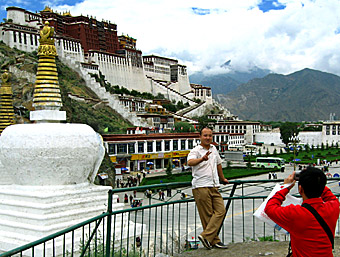
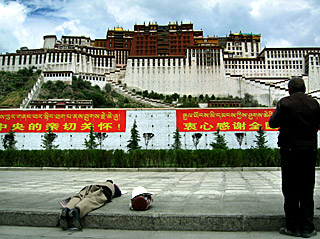 The real problem, points out Robert
Thurmond, Tibetan expert at Columbia University (and father of actress Uma) is
that Beijing never consulted locals. “Tibetans
are opposed to everything China does, since whatever it is, it is used by
control to complete the genocide of Tibetans, by economic privation and now by
assimilation.”
The real problem, points out Robert
Thurmond, Tibetan expert at Columbia University (and father of actress Uma) is
that Beijing never consulted locals. “Tibetans
are opposed to everything China does, since whatever it is, it is used by
control to complete the genocide of Tibetans, by economic privation and now by
assimilation.”
The clash is keenest at places like the Potala Palace, the spectacular castle that housed the reincarnated Dalai Lama for centuries. Pilgrims trek for weeks to prostrate themselves before the sacred home of their God King. Now, they jostle with Chinese group tours. The site has become so crowded that quotas were recently imposed to control the Potala crush.
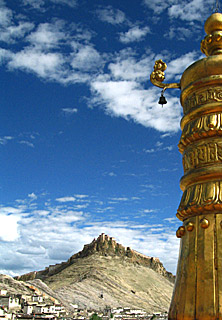 Outside Lhasa, the impacts were no less
severe. Previously, few references to China could be found outside new districts
in Tibet’s main cities. Now, Chinese shops and malls, many under construction,
stretch for miles into the countryside.
Outside Lhasa, the impacts were no less
severe. Previously, few references to China could be found outside new districts
in Tibet’s main cities. Now, Chinese shops and malls, many under construction,
stretch for miles into the countryside.
In Shigatse, I witnessed the rare unveiling of a 10-story thangka (Buddhist scroll). Surrounded by prayer-wheel toting Tibetans, the blissful scene could have fit any distant century. Leaving Shigatse, I was yanked back to reality by the sight of a sprawling development of modern villas. Tibet, seemingly, is up for grabs.
And this is before the train gets up to speed. Only three routes were running on July 1, rushed into service to mark the 85th anniversary of the founding of the Communist Party and the return of Hong Kong to China in 1997.
Stations on the route were under construction and ticketing was chaotic, with widespread scalping. Facilities on board were basic, and food ran out early.
That should change by the end of 2007 or early 2008, when a luxury line is to be launched offering plush restaurant cars, butler service and $1,000-a-day touring packages.
Booking companies are already taking reservations for the Tanggula Express, which Bill Edwards of RailPartners promised would be among “the most magnificent trains in the world.” Initially there will be three routes, from Beijing to Tibet, Beijing to Dali, and Shenzhen (near Hong Kong) to Lhasa.
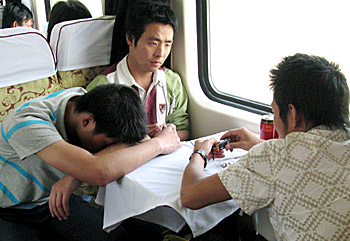 Of course, with only 12 sleeping cars per
train, the line is unlikely to add much to the impact of the railway. Anyway,
few object to high-spending foreigners, or even Chinese group tours. The real
worry is who will fill all the cheap seats.
Of course, with only 12 sleeping cars per
train, the line is unlikely to add much to the impact of the railway. Anyway,
few object to high-spending foreigners, or even Chinese group tours. The real
worry is who will fill all the cheap seats.
Around Tibet, I heard the same concern, that the train would only bring more Chinese workers to, as one guide said, “take our jobs and our houses, just like they already did our land.” Only a handful of Tibetans were among passengers on my train. None worked on board, or at Lhasa’s massive new station, except those polishing the marble floors or sweeping up outside.
Even Chinese residents like Xiao Liu conceded concern. “With the train, so many people can come. I worry that Tibet will lose its mystery.” Lilly, from Shanghai, who was opening a music shop down the lane added: “Tibet has been a secret land, filled with magic, for so long.
“Now,” she lamented, “it won’t be secret anymore.”
Ron Gluckman is an American reporter an American reporter who has been roaming around Asia since 1991, whenever possible by rail. He was among the first independent journalists on the Tibet train when it launched in July 2006, filing many stories on the new railway and its impact. This piece is the original version of a story that ran in Destinasian Magazine in October 2006.
All pictures by Ron Gluckman
All material copyright RON GLUCKMAN
To return to the opening page and index
push here
[right.htm]
